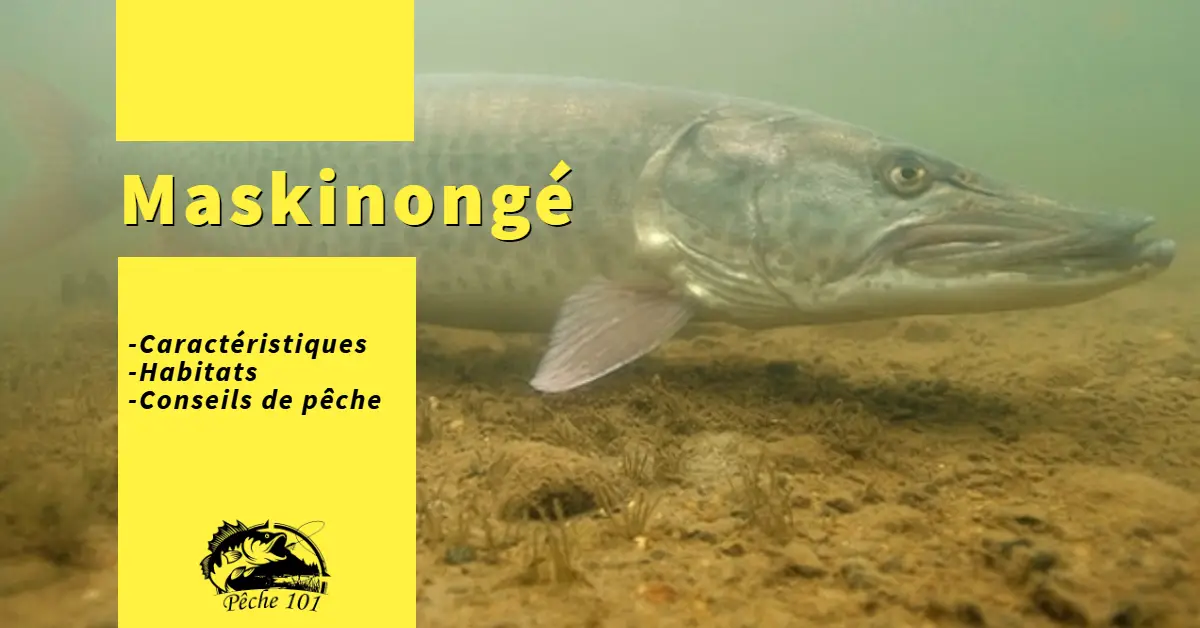Muskellunge fishing is an intense and sometimes tricky activity, very popular in Quebec.
This large solitary fish, also known as 'Musky', 'Maski', 'Muskie', is sought after for its impressive size and combativeness when shod.
To increase your chances of success, it's important to be well-equipped and to know the specific fishing techniques for catching this fish.
We'll cover not only fishing techniques, but also other important aspects of muskie fishing, such as habitat, seasonal patterns, and much more.
Article content
- 1 Behavior and Characteristics of the Maskinongé
- 2 Physical characteristics of Maskinongé
- 3 Understanding the Seasons
- 4 Maskinongé Fishing Techniques
- 5 Musky length vs. weight conversion
- 6 Fishing spots Maskinongé
- 7 Common Challenges and Errors
- 8 Conservation and Respect for the Ecosystem
- 9 Frequently asked questions
- 10 Author
Behavior and Characteristics of the Maskinongé
A summary of Maskinongé
| Features | Information |
|---|---|
| Scientific name | Esox masquinongy |
| Common names | maskinongé, musky, muskie |
| Power supply | Carnivorous - mainly fish such as pike, perch and bluegill, but also frogs, muskrats, ducks and other small aquatic animals. |
| Native range | North America, mainly in the Great Lakes, St. Lawrence and Mississippi regions |
| Preferred environment | Freshwater lakes, rivers and reservoirs with dense vegetation and a sandy, muddy or rocky bottom. |
| Preferred water temperature | Between 15 and 24 degrees Celsius (59-75 degrees Fahrenheit) |
| Temperature tolerance | Tolerates temperature range but prefers cooler waters. |
| Average life expectancy | Approximately 15 to 20 years |
| Medium size | Generally 76 to 114 centimetres in length |
| Average weight | Varies between 6.8 and 13.6 kg, but some specimens can exceed 31.7 kg. |
Food and Prey
The muskellunge is a voracious predator.
It feeds on several species of fishBut it can also feed on frogs, birds and small mammals when the opportunity arises.
It's important to note that the size of the prey often determines the size of the muskellunge capable of capturing it.
So, if you're looking to catch a large muskie, make sure you use the right size lures to attract this fish.
Spawning behaviour
During the spawning period, muskellunge behavior changes.
Spawning generally takes place in spring, when water temperatures are between 9 and 15°C.
They spawn in very shallow water. More specifically, these fish seek out areas close to shore with a maximum depth of 2 to 3 feet for reproduction.
During this period, the male and female swim together and the female releases her eggs, which the male then fertilizes.
It is recommended to avoid fishing muskellunge during the spawning period to protect populations and ensure a sustainable fishing experience.
Muskellunge spawn from late March to mid-June. In Quebec, fishing is prohibited during this period.
Check the opening and closing times for musky fishing before you go.
Understanding Eating Habits
To fish successfully for muskellunge, it's essential to pay attention to its eating habits.
The muskellunge is an opportunistic hunter and attacks its prey by approaching it discreetly, often positioning itself behind it to be out of its field of vision.
They prefer protein-rich fish such as catfish and carp.
By knowing and understanding muskellunge feeding habits, you can adjust your fishing technique and choose the right lures to increase your chances of success.
Physical characteristics of Maskinongé
The muskellunge is a carnivorous fish with a long, streamlined body. Its snout is pointed and flattened on top, and its large mouth is equipped with sharp teeth. The dorsal fin is close to the tail and the caudal fin is deeply forked.
Physically, the muskellunge is very similar to the pike.
However, there are some major differences between these two species.
Muskellunge caudal fin tips are pointed, while those of pike are round. Muskellunge also have stripes, while pike have spots.
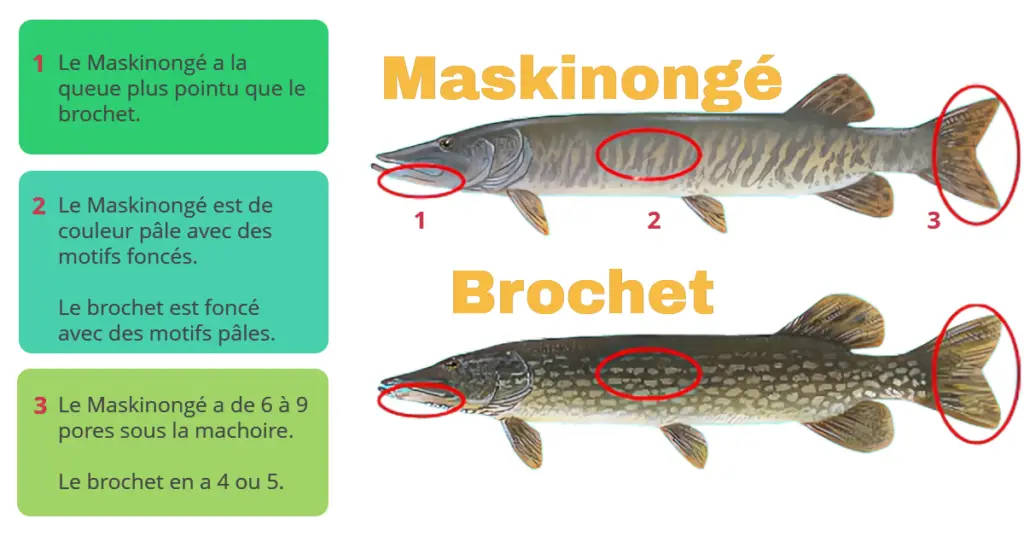
When fishing for muskellunge, the aim is generally to catch the largest specimens of the species, fish measuring up to 50 inches (127 cm).
Understanding the Seasons
Spring Musky Fishing
If you choose to fish in spring, especially early in the season, bear in mind that waters can be colder, barely above 15°C (60°F).
Muskellunge are often still close to their spawning grounds.
Opt for spinnerbait and crankbait slightly smaller than those generally used for musky.
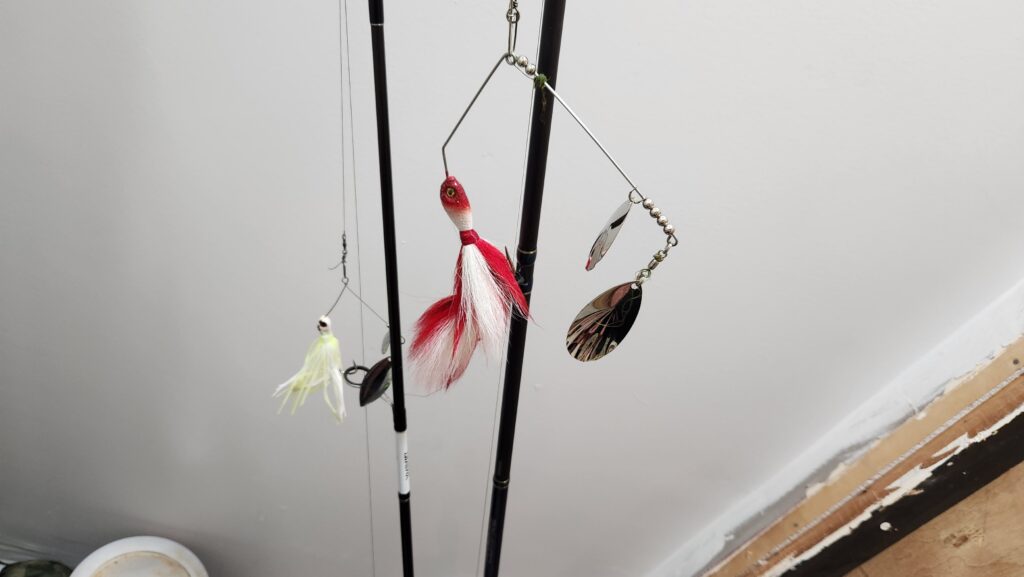
Shallow areas, such as those between 0.6 and 1.8 meters (2 and 6 feet), are often the muskellunge's favorite springtime haunts.
They hunt baitfish that haven't yet migrated to greater depths.
However, in lakes where prey such as ciscoes predominate, muskellunge may move to deeper, suspended pools, cruising at modest depths, perhaps 3 to 4.5 meters (10 to 15 feet) in clear lakes.
In darker waters, they could be even closer to the surface.
Don't forget to use polarized glasses to spot fish following your lure. If they don't seem interested during the day, come back during low-light hours, like dusk.
Often, fish behavior can change with light, making fishing more fruitful in the dark.
Fishing the Maskinongé in summer
In summer, muskie fishing is particularly productive. With water temperatures fluctuating between 18°C and 24°C, these fish become very active.
They adopt a variety of hunting techniques: some rise from the bottom, others attack from their hiding places, and a few swim in open water, sometimes following the lure for long periods without biting.
The major issue for anglers is these "follower" muskies. To entice them to bite, it's essential to give the impression that the lure is about to get away from them.
It is advisable to shake the line vigorously or vary the retrieval speed rapidly.
When towing, a speed of 9.6 to 12.9 km/h is ideal.
Brightly coloured lures such as Fire Tiger, Rouge and Chartreuse are proving effective, partly due to the reduction in water clarity caused by algae blooms.
When casting your line, vary your casting and retrieving techniques to surprise these clever fish.
The key is to make the lure unpredictable, imitating easy-to-catch prey.
Autumn and fishing in Maskinongé
During the pre-spill period, from late August to late September, conditions become particularly favourable for muskellunge fishing.
This period is characterized by the movement of fish from the depths to shallower areas, particularly when water temperatures drop below 70 degrees Fahrenheit.
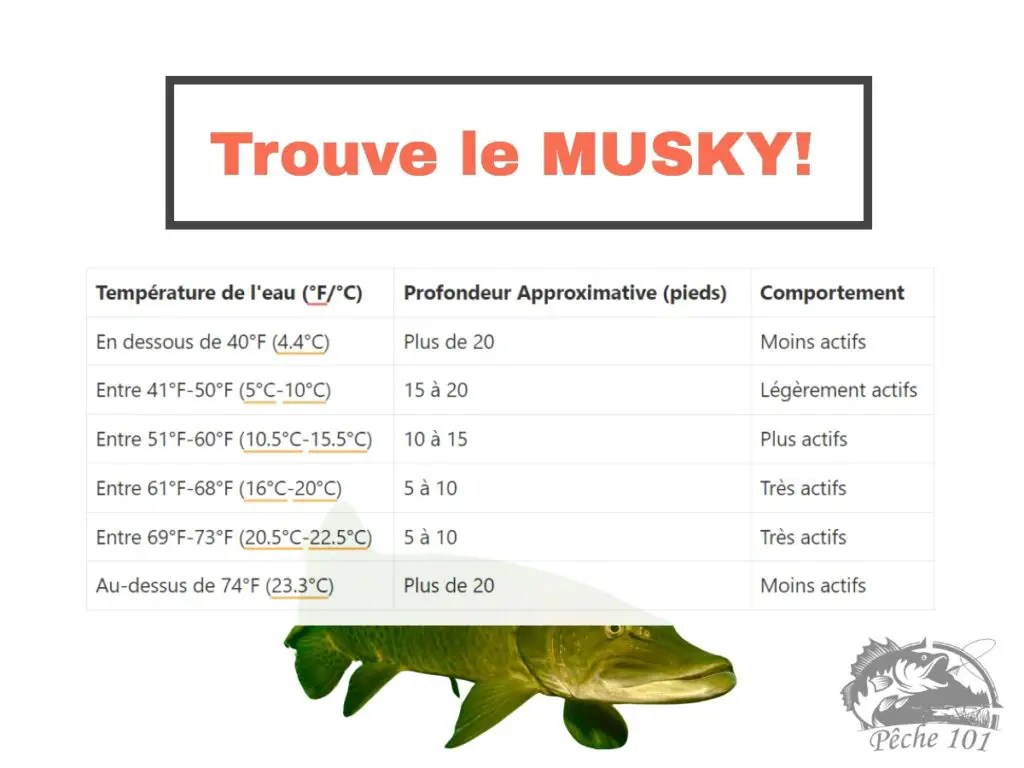
Shallow water, green meadows and rocky areas are favored.
Large lures, such as bucktails or surface lures, are particularly effective during this period.
The use of sturdy rods, at least 8′ long, is recommended to master these imposing fish.
Lure retrieval speed is not as critical as in summer.
It's advisable to use strong braided wires, ranging from 80 to 100 pounds, especially in areas with heavy vegetation or large structures.
The phases of the moon are also important during this month, with a predilection for cloudy days during the full or new moon.
Water depths of 5′ to 12′ are ideal.
In terms of equipment, the cane Mojo Musky 9'6" MHFT is highlighted for fast lure retrieval. Thanks to its extra length, this rod is not only ideal for increasing casting distance, but also excels in executing effective lure movements.

September is undoubtedly the ideal time to be on the water if you're looking to catch a muskie.
But with the arrival of the first cold snaps, it's essential to take advantage of these favorable conditions quickly, as fish will head for deeper structures as the month progresses.
For more tips and techniques, consult our fall muskie fishing guide. Small details can make a big difference!
Maskinongé in Winter
When the lakes start to freeze over in early winter, muskies are often found in the same areas as in autumn.
These fish, staying mainly close to the bottom, are typically found in waters 10 to 15 feet deep.
The most promising places to find them include weedlines, channel breaks, points, shore bars and inside bends.
But as winter progresses, they tend to head for deeper waters.
To maximize your chances of catching a musky, a mixed approach is recommended.
Use the tip-up with a quick-strike assembly. It's essential to opt for a strong wire leader, as musky is renowned for its sharp cuts. When setting up your tip-ups, be sure to space them at least 20 meters apart to effectively cover a larger expanse of water.
In addition to tip-ups, the jigging technique is also effective. With a jigging rod placed close to a tip-up, you increase your chances of attracting fish. Lures like the Rapala Jigging Rap or Kastmaster spoons can be particularly effective for this method.
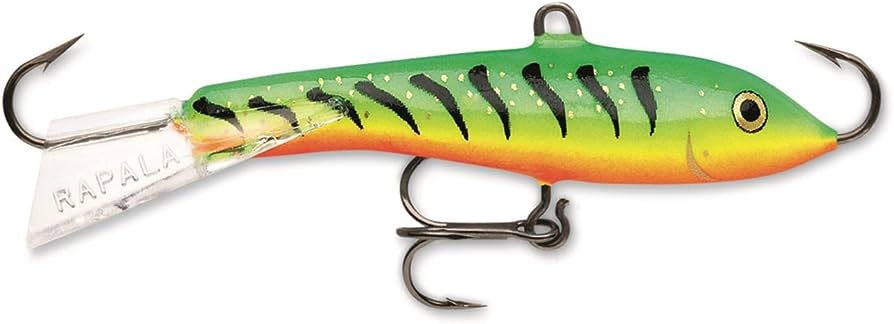
Maskinongé Fishing Techniques
Throwing techniques
To cast for muskellunge, it's important to choose the right lures.
Visit rippling spoonsspinnerbaits and large soft lures are often used for this fishing technique.
You can also opt for surface lures, as muskellunge often attack prey close to the water surface.
The figure-8 to catch more muskellunge
The "figure-of-8" technique is a favourite among muskie anglers. Long known in the world of muskie fishing, only a few initiates have truly mastered this incredibly effective retrieve technique.
Its effectiveness is a direct result of the way the muskie hunts.
John Anderson, owner and operator of theOttawa River Musky Factory", claims that performing a "figure-of-8" fishing manoeuvre at the end of each cast is one of the easiest ways to catch more musky.
"Every year, we catch between 150 and 200 muskies, and 35 to 40 % of them are caught at our feet, next to the boat."
John Anderson
For him, omitting this technique means missing out on one of the most exciting moments in freshwater fishing.
There's nothing like the thrill of watching a 50-inch fish swirl around your bait before violently pouncing on it.
The principle of the "figure of 8" is to perform a series of movements with the fishing rod, close to the boat, to give the illusion of prey trying to escape, thus triggering the attack of the muskie that follows.
While some anglers only use this technique when they see a muskie, Anderson advises doing it after every cast, as it's sometimes difficult to spot a big fish following the bait.
In practice, the transition from a cast to a "figure of 8" requires a series of precise steps. These include abruptly changing the direction of the lure at a distance of 10 to 15 feet from the boat, then entering the "figure-of-8" sequence.
Movements should be fluid and constant, ensuring that the lure continues to move at the same speed as during retrieve.
For greater effectiveness, you can also add variations, such as changing the speed of the lure on bends.
When a muskie attacks, the key is to strike horizontally towards the tail of the fish, and above all to keep the tip of the rod in the water to prevent the fish from sticking its head out.
Don't forget to bring along solid fishing equipment, as muskie attacks are fast and powerful. Use a sturdy rod and reel to master these big, strong fish.
Troll fishing
Trolling vs. Casting
Although the majority of muskies are caught by casting, nearly 30% of them are caught by trolling.
This method is particularly effective in high winds, at depths difficult to reach by casting, or at speeds difficult to reach by casting.
What's more, trolling allows you to get to know a body of water quickly and discover new places to fish.
Equipment
Knowledge of the depths at which lures swim is essential.
The use of a reel with line counter is recommended as it is crucial to know how much line you have deployed.
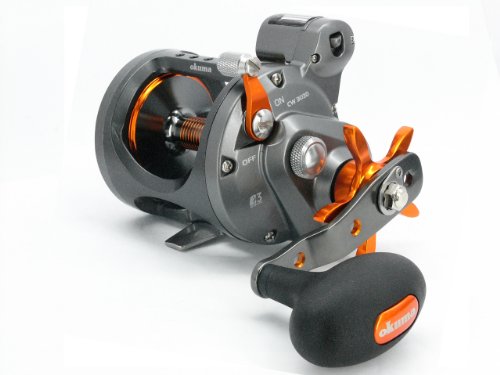
In rocky waters or with underwater weeds, precise control of the lure is the key to success.
Braided line is generally preferred for trolling, and the type of rod can greatly influence your success.
Don't forget to use 60+ lb steel wire or fluorocarbon leaders and 3-foot trolling lines.
Trolling tips
Keep an eye on your lure's location, especially around salient points.
The speed of the lure changes as it turns; those on the inside slow down, while those on the outside speed up.
It can be advantageous to hold the cane in your hand rather than leaving it in a cane holder to get a better feel for the strokes.
If your lure gets stuck, several techniques can be used to retrieve it, including turning the boat around or using a lure retriever.
Decoy options
The drag is ideal for large, overgrown areas.
Blade lures, such as spinnerbaits or bucktails, are effective in waters where weeds are 1 to 3 feet below the surface.
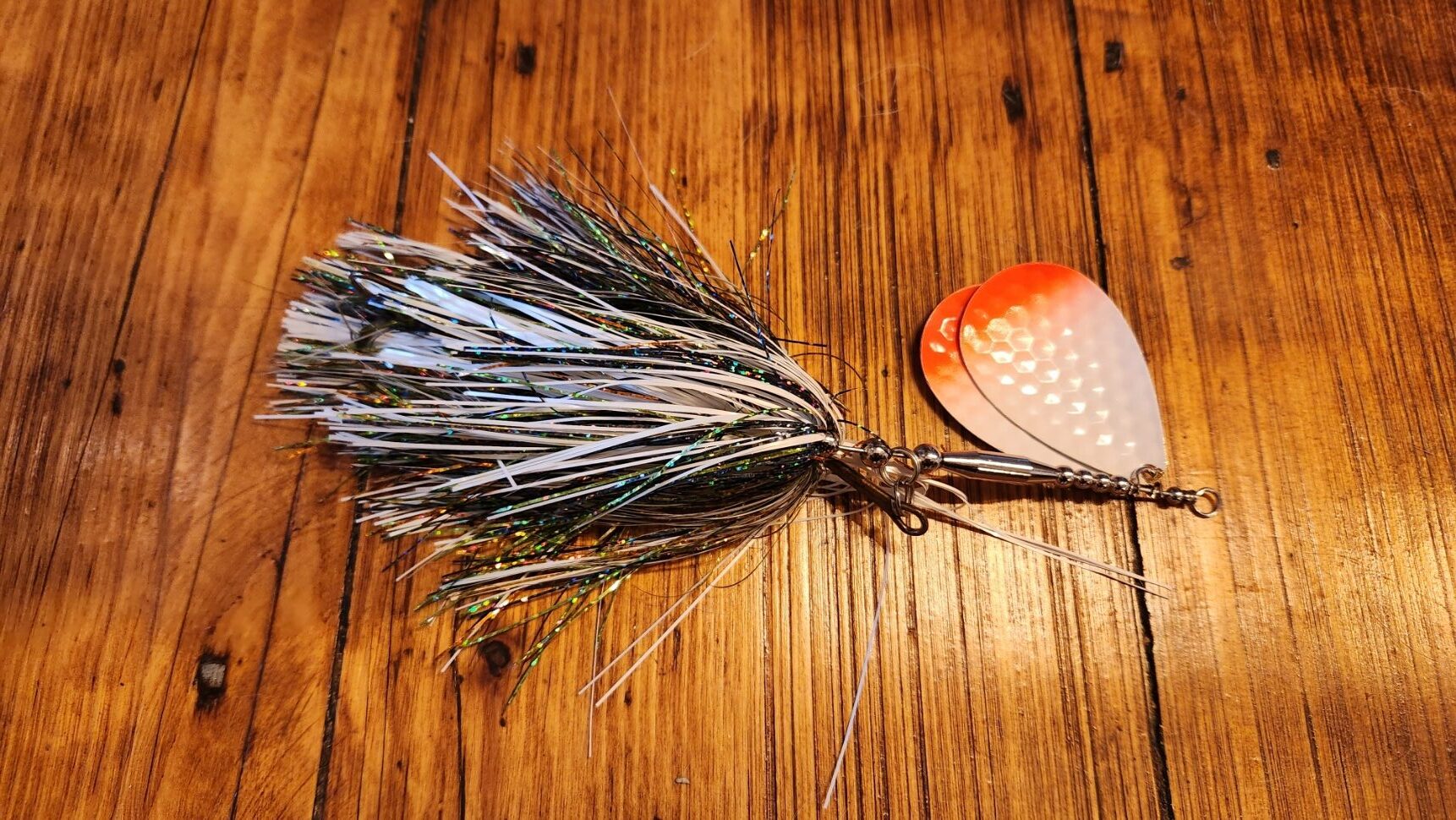
For depths of 4 to 7 feet, opt for surface lures or weighted jerkbaits.
The deep edges of the sea grass beds are ideal for trolling.
Breaklines such as seagrass edges, drop-offs, variations in water color or currents can be particularly attractive to muskies.
Musky length vs. weight conversion
To measure the total length of a muskie, start from the tip of the snout to the tip of the upper lobe of the caudal fin (or tail).
The tape measure should be laid flat along the entire length of the fish's back, along the dorsal line, and extended to the upper lobe of the caudal fin.
| Length | Small | Average | Big |
|---|---|---|---|
| 36 | 9-11 lbs. | 12-13 lbs. | 14-15 lbs. |
| 40 | 12-15 lbs. | 16-18 lbs. | 19-20 lbs. |
| 42 | 15-18 lbs. | 19-22 lbs. | 23-25 lbs. |
| 45 | 19-22 lbs. | 23-27 lbs. | 28-30 lbs. |
| 48 | 22-28 lbs. | 29-32 lbs. | 33-36 lbs. |
| 50 | 24-31 lbs. | 32-37 lbs. | 38-45 lbs. |
| 52 | 28-35 lbs. | 36-42 lbs. | 43-50 lbs. |
| 55 | 33-41 lbs. | 42-46 lbs. | 47-55 lbs. |
| 58 | 40-48 lbs. | 49-57 lbs. | 58-65 lbs. |

Measuring muskies instead of weighing them with traditional scales offers several advantages, mainly focused on fish welfare and accuracy.
Firstly, the weighing process, particularly with traditional scales, can impose unnecessary stress on the fish, increasing the risk of injury or mortality once released.
Lifting a muskie out of the water with a scale can damage its internal organs or spine, due to the uneven weight distribution.
What's more, scales can often be inaccurate, especially if they are not regularly calibrated.
Conversely, a length measurement carried out correctly with a tape measure is often more accurate and a reliable reflection of the fish's overall size and health.
Ultimately, measuring a muskie is not only safer for the fish, but also offers a more reliable method of assessing its size.
Use the following table to get an accurate idea of the weight of your muskellunge:

Fishing spots Maskinongé
Popular Lakes and Rivers in Quebec
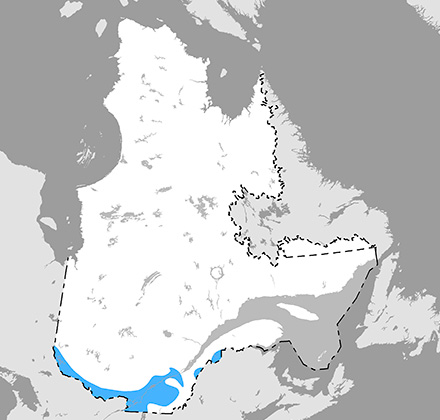
Quebec is a province rich in musky lakes and rivers. Among the popular Musky fishing areas, Lac Saint-François and Lac des deux-montagnes offer good opportunities.
Here's a list of lakes and rivers known to have muskellunge in Quebec:
| Lake Archambault | Lac des Îles | Lake Mandeville |
| Lac aux Barges | Bark Lake | Lake Maskinongé |
| Lac aux Oreilles | Lac du Camp | Lac Masson |
| Lac Beau | Lac du Cerf | Lake Mekinac |
| Beaven Lake | Lake Dusseau | Black Lake |
| Lac Bois Franc | Lac Dussault | Original Lake |
| Lac Brûlé | Lac ducont | Lac Ouareau |
| Lake Champlain | Echo Lake | Lac Ouimet |
| Lake Charlopin | Lac Équerre | Lake Plombagine |
| Lac Croche | Lac Français | Lac Poulin |
| Lake Deligny | Lac Gauvin | Lac Quenouille |
| Donaldson Lake | Lac Gauvreau | Lac Roberge |
| East Lake | Lac Jeune | Lac Rocheleau |
| Lac de l'Orignal | Lac Joseph | Lac Saint-Augustin |
| Lac de la Digue | Lac Lemay | Lac Saint-François |
| Lac des Becs-Croisés | Lac Leverrier | Lake Saint-Joseph |
| Lac des Chicots | McNab Lake | Lake Saint-Louis |
| Lake of Two Mountains | Medusa Lake | Lac Saint-Malo |
| Ottawa Lake | Original Lake | Lake Sainte-Marie |
| Lake Dusseau | Lake Simon | Lac Saint-Pierre |
| Frontier Lake | Lake Superior | Lake Saguay |
| Lac Jeune | Lake Tarbell | Lake Tremblant |
| Lac Lemay | Vic Lake | Viking Lake |
| Lake Mandeville | William Lake | Lake Willie |
| Lake Maskinongé | Nominingue Lakes | Le Richelieu |
| Chaudière River | Achigan River | Bass River |
| Thousand Islands River | Ottawa River | Rivière l'Assomption |
| Rivière des Prairies | Rivière du Nord | Lièvre River |
| Yamaska River | Saint-François River | Black River |
Note that this list may not be 100% accurate, and that it's very likely that you'll find musky elsewhere in Quebec. But it may give you a good idea of where to go for your next fishing trip.
Understanding the Maskinongé Habitat
To increase your chances of success, it's essential to know and understand the muskellunge's natural habitat.
This predatory fish is generally found in shallow, vegetation-rich areas, where it hides to catch its prey.
Muskellunge also prefer the banks of rivers, lakes and rocky areas for feeding and breeding.
Fishing in dense vegetation
Fishing in dense vegetation can be an effective approach to catching muskellunge.
Areas of grasses, water lilies and aquatic plants provide ideal habitat for muskellunge and their prey.
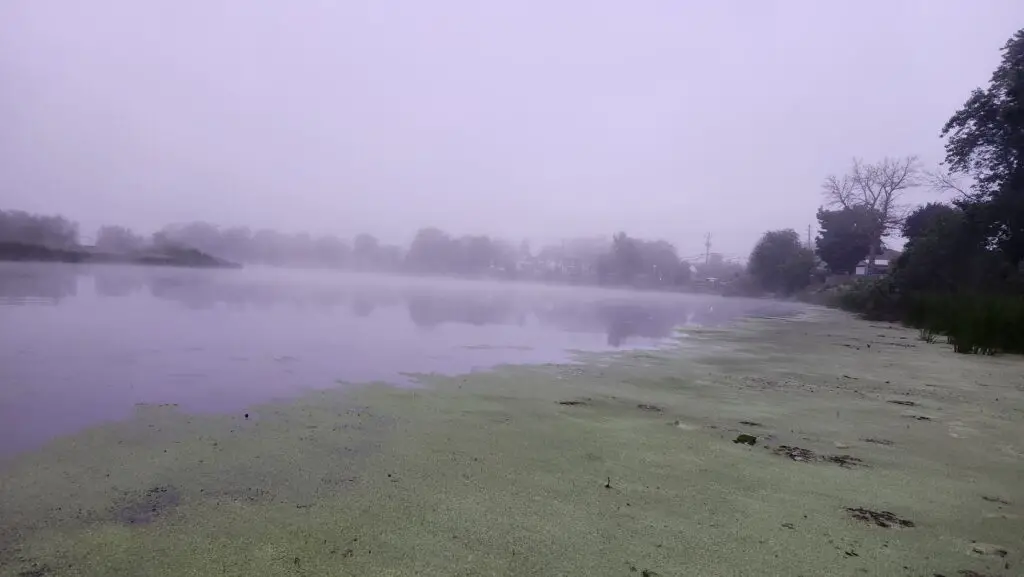
To fish in these areas, use lures that pass easily through the vegetation, and be patient and persistent, as muskellunge can be difficult to catch.
Remember that muskie fishing requires the right approach, knowledge of the habitat and the right equipment.
Common Challenges and Errors
Common Musky Fishing Mistakes
When fishing for muskellunge, it's crucial to avoid certain common mistakes to increase your chances of success. Here are a few mistakes to avoid:
- Approaching too quickly and being noisy: Muskellunge are wary fish, sensitive to noise and movement. So be careful not to approach their zone too quickly, and keep a low profile when moving around.
- Be visible: Try to camouflage yourself as much as possible and avoid wearing clothes that are too flashy.
- Poor preparation: Make sure you have the right equipment (rods, reels, lures) and are familiar with specific muskie fishing techniques.
- Ignore weather conditions and lunar phase : These factors can have an impact on muskie activity. Adapt your fishing techniques to current conditions to maximize your chances of success.
Défis de la Pêche Maskinongé
Fishing for muskellunge presents several challenges that you must overcome to successfully catch this solitary and combative fish. Here are just a few of them:
- Locate the fish : Finding the muskellunge's preferred habitat can be difficult, as it often moves alone. Concentrate on deep pits, underwater structures and areas of vegetation where it is likely to hide.
- Master fishing techniques : The muskie is a combative fish and difficult to catch. It is essential to master the techniques specific to muskie fishing, such as lure animation, striking and fighting (see above for tips).
- Adapt your equipment : The muskie is a powerful fish. Remember to use rods and reels adapted to fishing this big fish, as well as strong lures and hooks. Muskie fishing equipment is expensive, but necessary.
Conservation and Respect for the Ecosystem
Responsible Fishing Practices
To preserve the ecosystem and ensure the sustainability of muskellunge fishing, it's important to follow certain responsible practices.
First and foremost, comply with the rules and regulations laid down by local authorities. This includes fishing licenses, size and possession limits, and authorized fishing periods.

Also remember to use barbless hooks or to crush the barb to facilitate fish release and minimize injury.
When handling muskellunge, exercise care and respect to minimize stress and damage to the fish.
Always hold the muskellunge horizontally. Doing otherwise could seriously injure or even kill it.
Return it to the water as soon as possible.
Contribution to Conservation
As a fisherman, you can contribute to the conservation of species and the protection of the ecosystem by adopting responsible practices.
For example, by avoiding over-fishing and respecting protected areas to maintain biological diversity.
Also, be sure not to disturb sensitive habitats and wetlands during your fishing activities.
Get involved in conservation efforts by supporting and participating in habitat restoration projects, or by sharing your knowledge and passion for muskie fishing with others.
Encourage other anglers to adopt environmentally-friendly practices and to be concerned about the preservation of aquatic species and ecosystems.
Frequently asked questions
How can you tell a pike from a muskie?
Muskellunge are often confused with northern pike. However, it is possible to differentiate them by a few details. Muskellunge have finer flesh and their behaviour is less predictable than that of pike. Muskellunge are also generally larger than pike.
What lures should you use to catch muskellunge?
For muskie fishing, the most commonly used lures are large wobbling spoons, spinnerbaits and very large lures. Don't hesitate to vary lure types to maximize your chances of catching a muskie.
Which fly is right for muskie fishing?
Muskie fly-fishing is not very common, but there are flies that can be effective in catching this fish. Try streamer flies or larger flies to attract the muskie's attention.
Where to find the best muskie fishing spots in Quebec?
In Quebec, the St. Lawrence and Ottawa rivers are renowned for world-class muskie fishing. Don't hesitate to explore these areas to increase your chances of catching a large muskie.
When is the best time to fish for muskellunge?
The best season for muskie fishing depends on the region you're fishing in. In general, the months of May and June offer the best opportunities, as muskellunge are found close to spawning grounds. However, you can also have success muskie fishing during summer and autumn, when waters are warmer and fish are more active.
